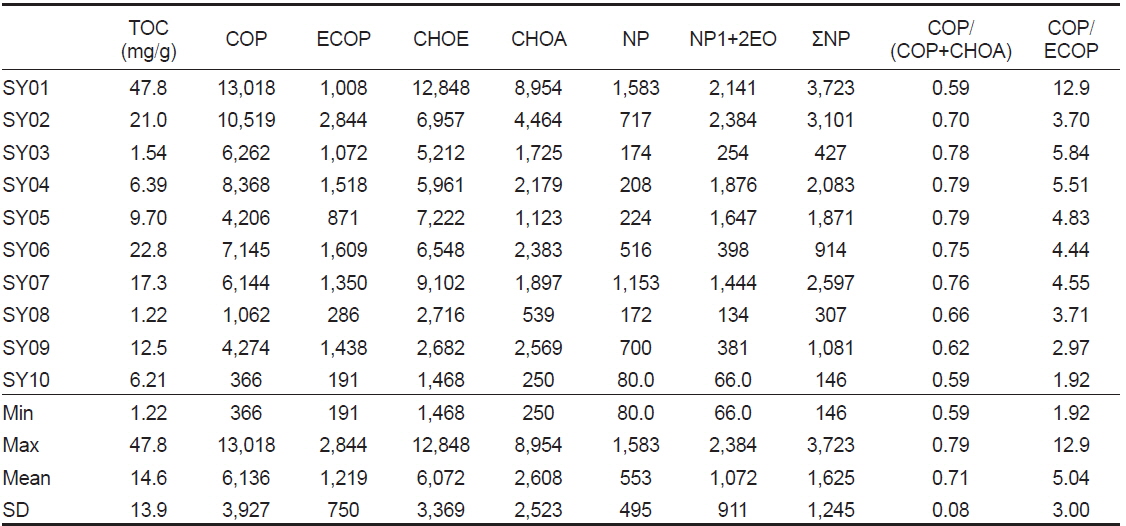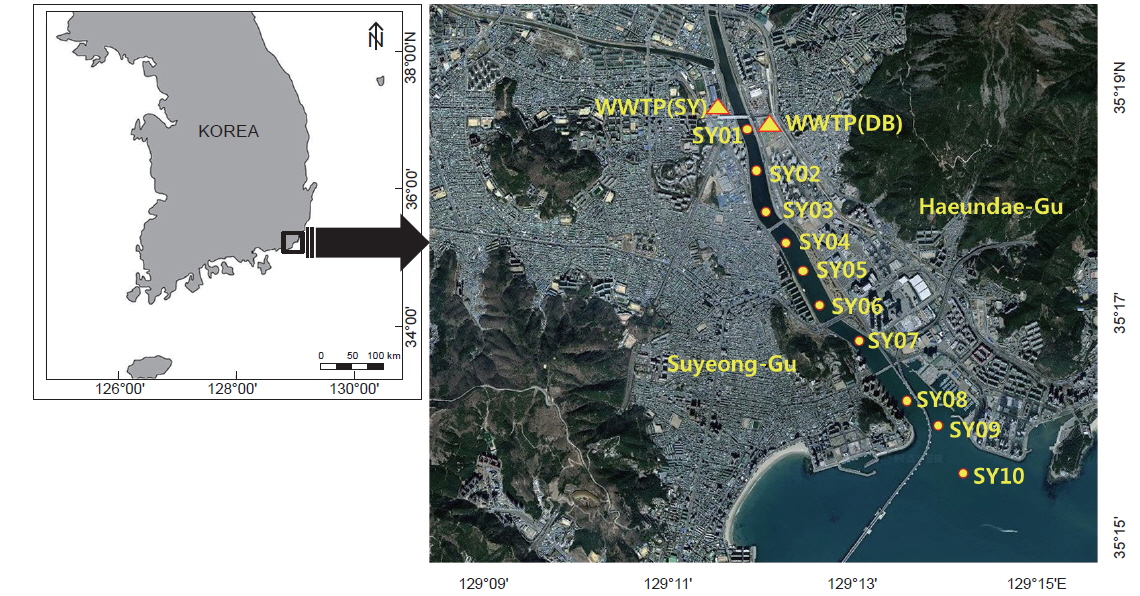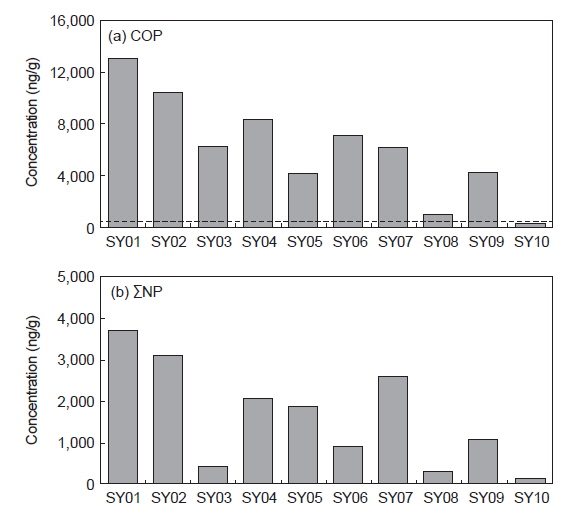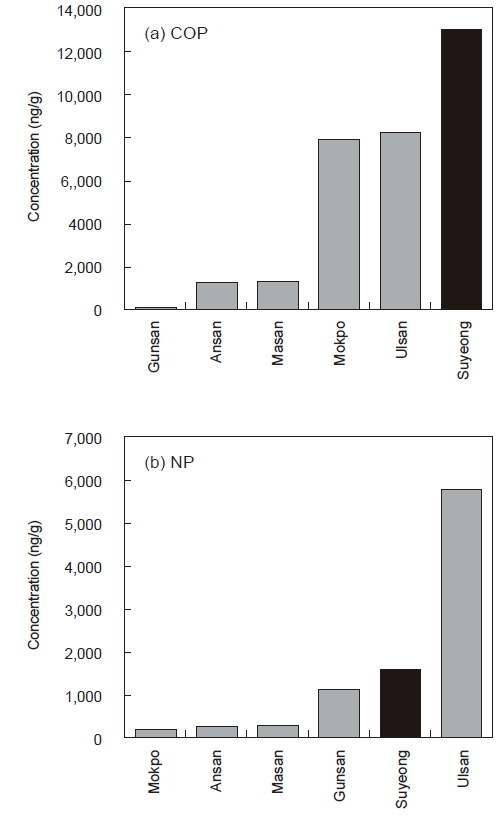



부산 수영강은 온천천, 동래천, 석대천의 지류를 가지고 있으며, 총 연장 28 km, 폭 50-90 m이고 전체 면적은 200 km2에 달하며, 동해바다로 직접 연결된다. 수영강 하구역(estuary) 주변은 주거지역, 상업지역, 공업지역이 혼재된 지역으로, 주변에 대형주거단지가 건설됨에 따라 도시화되면서 오염화가 가중된 대표적인 지역이다(Kwon et al., 2008). 수영강 하구역에는 중대형인 수영(SY)과 동부(DB) 하수처리장이 위치하고 있고, 방류수는 수영강을 통해 연안으로 배출된다(ME, 2012). SY 하수처리장은 1985년에 건설되었으며, 하루에 452,000 톤의 하수를 처리하는 부산에서 가장 큰 하수처리장 중 하나이며, 표준활성 슬러지법(activated sludge treatment process)으로 처리 후 방류수를 배출하고 있다. DB 하수처리장은 2007년에 건설되었으며, 하루에 135,000 톤의 하수를 처리하고 있으며, 최종처리방법은 생물막여과법(biofilm filteration process)을 이용하고 있다. 또한, 수영강 하구역은 동래구, 수영구, 해운대구가 위치하고 있으며, 이들의 하수관거 보급율은 46-51%으로 전국 평균 73%에 크게 낮고, 우수관거 보급률은 2.4-18.9%로 전국 평균 59%에 크게 낮은 수준으로 도시하수(municipal effluents)로 인한 오염이 우려된다(ME, 2012). Kim et al. (2009)은 수영강 수계 퇴적물 조사결과에서 수영강 중류지역은 중금속과 총인이 미국환경청의 퇴적물기준을 초과하는 수준의 오염도를 보고한 바 있다. Jeon et al. (2010)의 저서성 대형무척추동물과 어류를 이용해 수영강 중류 수생태 건강성을 평가한 연구결과에 따르면, 약간나쁨(B등급)-아주나쁨(D등급) 수준으로 평가되었지만, 수영강 하구역에서 환경오염도에 대한 연구는 현재 매우 미비한 실정이다. 따라서 하수처리장 방류수 뿐만 아니라 다양한 하수가 유입하는 수영강 하구역에서 도시하수로 인한 오염도를 평가하는 것은 매우 중요하다.
도시하수로 인한 오염을 모니터링하기 위해, 분변계스테롤(fecal sterols)과 노닐페놀류(nonylphenolic compounds; NPs)를 많이 이용하고 있다(Li et al., 2008; Froehner et al., 2009; Choi et al., 2009, 2011a; Kim et al., 2010; Lee et al., 2012; Choi et al., 2014). 분변계스테롤중 coprostanol (COP)은 포유류의 장에서 cholesterol (CHOE)로부터 생성되는 주요한 분변계스테롤로서, 인간이 배설하는 분변계스테롤 중 50-80%를 차지하고 있어서 수생태계 중 분변오염의 지시자로 널리 활용되고 있다(Leeming et al., 1996; Chan et al., 1998). 분변계스테롤은 독특한 분포특성을 가지고 있어서 COP 및 cholestanol (CHOA)와 같은 분변계스테롤과의 분포특성을 비교하면 하수기인오염에 대한 유용한 정보를 제공하며, COP/(COP+CHOA) 비율이 0.3이하이면 비오염, 0.6이상이면 도시하수로 인한 오염을 의미한다(Grimalt et al., 1990). NPs는 비이온계면활성제(nonionic surfactants)의 분해물질(biodegradation products)이다. NPs는 1940년 이후로 가정용/상업용세제 및 산업공정에 널리 사용되다가 유해성이 보고되면서 선진국을 중심으로 사용 규제되었다. 국내에서도 2007년부터 가정용으로 전면 사용금지되었지만, 현재도 하수처리장 방류수, 하천수, 해수, 퇴적물 등에서 널리 검출되고 있다(Choi et al., 2011a; Lee et al., 2012; Choi et al., 2014).
본 연구에서는 수영강 하구역에 위치한 하수처리장 배출구로부터 동백섬 인근까지 일정간격별 퇴적물을 채취한 후, 하수기인 오염지시자(분변계스테롤과 NPs)를 분석하여 수영강의 도시하수로 인한 오염수준을 파악하였다.
부산 수영강 하구역 퇴적물은 2010년 6월에 하수처리장 방류구 인근부터 해운대 동백섬 인근까지 10개 정점(SY01-SY10)에서 채취하였다(Fig. 1). 퇴적물 시료는 van Veen grab sampler를 이용하여 표층(<4 cm)을 채취하였으며, 채취된 퇴적물은 조사선에서 냉동하여 실험실로 운반하였다. 퇴적물 시료는 동결건조하고 균질화하여 2 mm 체로 걸러 갈색병(amber bottle)에 보관하였다.
분변계스테롤과 NPs의 분석은 Choi et al. (2009, 2011a, 2014)의 분석방법과 동일하게 수행하였다. 분변계스테롤의 분석대상성분은 COP, CHOA, CHOE, epicoprostanol (ECOP)이며, 분변계스테롤의 전처리 과정은 다음과 같은 순서로 진행하였다. 우선 동결건조된 퇴적물 약 5 g을 테프론 원심분리관에 넣고, 내부표준물질 1-nonadecanol (Dr. Theodor Schuchardt & Co.) 주입 후, 추출용매 1:1 methylene chloride-chloroform(J.T. Baker, 잔류농약급)으로 60분간 2회 진탕하여 추출하였다. 추출시료는 질소농축하여 Florisil 컬럼(60-100 mesh, Sigma-Aldrich, 10 g)으로 방해물질을 제거하였다. 정제된 시료액은 다시 질소농축 후, 99:1 bis (trimethylsilyl) trifluoroacetamide-trimethylchlorosilane(Sigma-Aldrich)으로 유도체화하여 정량용 시료액으로 사용하였다.
NPs의 분석대상성분은 nonylphenol (NP), nonylphenol mono- & di-ethoxylates (NP1+2EO)이며, NPs의 전처리 과정은 다음과 같은 순서로 진행하였다. 테프론 원심분리관에 동결건조된 퇴적물 약 5 g을 넣고, 내부표준물질 nonylphenol-13C6(Cambridge Isotope Laboratories)을 주입 후, methylene chloride(J.T. Baker, 잔류농약급)로 60분간 2회 진탕 추출하였다. 추출시료는 1 mL까지 질소농축하여 활성된 구리(Sigma-Aldrich)로 황화합물을 제거하였다. 황화합물이 제거된 추출시료는 99:1 bis (trimethylsilyl) trifluoroacetamide-trimethylchlorosilane를 이용하여 유도체화한 후, Florisil 컬럼(1 g)으로 방해물질을 제거하였다. 정제된 시료액은 질소농축하여 정량용 시료액으로 사용하였으며, gas chromatograph-mass selective detector (Agilent 6890/5973N)로 정량하였다.
분변계스테롤과 NPs의 농도는 ng/g의 단위(건중량; dry weight)로 나타내었다. 분석대상성분의 검출한계(limit of detection)는 signal-to-noise ratio의 3배로 계산하였고, 분변계스테롤의 검출한계는 4-14 ng/g이었고, NPs는 1-4 ng/g이었다. 회수율(recovery)은 5개의 sea sand (washed sea sand, Fisher Scientific)에 분변계스테롤과 NPs 표준용액을 spike하여 동일한 전처리방법을 거친 후 계산하였다. 분변계스테롤의 회수율은 77±14%이었고, NPs는 104±15%이었다. 현장 퇴적물시 료에서 내부표준물질 nonylphenol-13C6 및 1-nonadecanol의 회수율은 각각 81±11%, 78±9.5%로 양호한 수준이었다.
퇴적물내 총유기탄소(Total organic carbon; TOC)는 1 N HCl(Merck, Suprapur 30%)로 calcium carbonate를 제거한 후, 원소분석기(Perkin Emler, Model 2400)로 정량하였다(Choi et al., 2011a).
퇴적물 내 COP의 농도는 366-13,018 ng/g (평균 6,136 ng/g)의 범위를 보였다(Table 1). COP의 가장 높은 농도(13,018 ng/g)는 SY와 DB 하수처리장 방류구 인근 SY01정점에서 조사되었고, 가장 낮은 농도는 외측 SY10에서 조사되었다(Fig. 2a). 수영강 하구역에서 COP의 농도는 하수처리장 방류구 인근에서 외측으로 갈수록 뚜렷한 감소 패턴을 보였다. 한편, 하수처리장 방류구의 하류에서 COP 농도가 조사정점 SY03과 SY05보다 SY04, SY06, SY07, SY09에서 다소 증가된 농도를 보였다. 이것은 수영강으로 유입되는 합류식 하수관거 월류수(combined sewer overflows: CSO)로 인한 영향일 수 있다. 조사정점 SY04와 SY06 주변에 CSO 유입구가 있었고, 이것은 우천시 미처리된 도시하수가 수영강으로 직접 유입될 수 있음을 의미한다. 퇴적물 내 COP 농도에 따라 하수영향수준 평가가 가능하며, COP 10 ng/g 이하의 농도이면 하수오염영향이 없는 해역(Hatcher and McCillivary, 1979), 100 ng/g 이상의 농도는 하수유입영향과 상관성이 있는 해역(Writer et al., 1995), 그리고 500 ng/g 이상의 농도는 하수처리장 방류수역으로 하수유입에 의한 상당한 분변 및 하수영향해역(Nichols et al., 1993; Gonzalez-Oreja and Saiz-Salinas, 1998)으로 보고된다. 본 연구에서 모든 정점이 100 ng/g 이상이었으며, SY10 정점을 제외한 9개 정점이 500 ng/g 이상으로 수영강 하구역은 분변 및 하수영향해역으로 확연히 구분되었다.

Concentrations (ng/g) of nonylphenolic compounds and fecal sterols in sediments from Busan Suyeong Estuary of Korea
수영강 하구역중 하수처리장 방류구 인근 퇴적물(SY01)에서 조사된 COP의 농도를 국내 다른 연안의 하수처리장 방류구 인근 퇴적물에서 보고된 자료와 비교하였다(Fig. 3a). 보고된 결과들은 본 조사결과와 같이 국가해양환경측정망 조사지침에 따라 동일한 시료채취 및 분석방법으로 생산된 자료로써, 오염수준 비교에 좋은 정보를 제공할 수 있다. 하수처리장 방류구 인근 COP농도는 군산연안(30 ng/g; Lee et al., 2012), 안산 시화반월공단(1,300 ng/g; Choi et al., 2011a), 마산만(1,380 ng/g; Moon et al., 2008), 목포연안(7,900 ng/g; Choi et al., 2007), 울산만(8,260 ng/g; Choi et al., 2011b)으로 수영강 하구역(13,018 ng/g)이 국내에서 가장 높은 수준의 오염도를 보였다. 국외의 하수처리장 방류수역 결과와 비교 시, 본 연구결과는 캐나다(150-38,000 ng/g; Mayer et al., 2007)와 미국(70-45,000 ng/g; Venkatesan et al., 2010)보다 낮은 수준이였으며, 베트남(5-4,800 ng/g; Isobe et al., 2002)보다 높은 수준으로 나타났다.
분변계스테롤은 배출원에 따라 특이한 분포패턴(profile)을 보인다. 인간과 다른 동물들(가축, 조류 및 해양포유류)의 배설물내 분포분포는 매우 상이하고, 해양플랑크톤과 식물들은 COP을 전혀 생성하지 않는다. 따라서 분변계스테롤의 분포 및 COP과 다른 스테롤 간의 비율 등은 배출원을 구분하는데 유용하다. COP과 ECOP는 인간의 배설물과 직접 관련성이 있어서 하수로 오염된 퇴적물에서 검출된다(Grimalt et al., 1990). 반면, 고래 등 해양포유류의 배설물에도 포함되기 때문에 이들의 영향은 생물기원배출(biogenic sources)으로 구분이 필요하다(Venkatesan and Santiago, 1989; Martins et al., 2002). 많은 연구자들은 생물기원 배출의 영향을 최소화하여 하수오염도 및 유기물의 기원을 평가하기 위해 COP 농도와 함께 여러 종류의 비율을 동시에 사용한다(Fig. 4). COP/ECOP 비율이 2.5이하시 생물기원 배출의 영향이 크므로, 비율 2.5이상과 COP 농도 100 ng/g 이상은 도시하수유입에 따른 오염과 관련성이 있다(Venkatesan and Santiago, 1989). 수영강 하구역의 퇴적물에서 조사된 COP/ECOP 비율은 5.04±3.00이었으며, SY10 정점을 제외한 모든 정점에서 모두 초과하여 생물기원보다 도시하수 유입으로 인한 오염이 주요 원인이었다. COP/(COP+CHOA) 비율은 하수오염 평가에 가장 널리 사용되고 있으며, 비율 0.5 이상과 함께 COP 100 ng/g이상인 정점도 도시하수유입으로 인한 오염으로 구분된다(Grmialt et al., 1990; Leeming et al., 1998). 본 연구에서 COP/(COP+CHOA) 비율은 0.71±0.08이었으며, 모든 정점에서 초과하였다. SY10 정점을 제외한 모든 정점이 COP/(COP+CHOA) 비율 0.5이상, COP/ECOP 2.5이상이었다. 따라서 분변계스테롤의 비율과 COP 농도 결과에서 보듯이, 수영강 하구역에서 COP 등 분변계스테롤의 농도는 생물보다 대부분 도시하수에서 기원하였다.
수영강 하구역의 퇴적물 내 NP와 NP1+2EO의 농도는 각각 80.0-1,583 ng/g (평균 553 ng/g), 66.0-2,384 ng/g (평균 1,072 ng/g)를 보였고, ΣNP (NP와 NP1+2EO의 합)의 농도는 146-3,723 ng/g (평균 1,625 ng/g)의 범위를 보였다(Table 1).
ΣNP의 가장 높은 농도(3,723 ng/g)는 하수처리장 방류구 인근 정점 SY01에서 조사되었고, 가장 낮은 농도는 외측 SY10에서 조사되었다(Fig. 2b). ΣNP의 농도는 내측에서 외측으로 갈수록 감소하였다. ΣNP의 공간적 분포는 COP의 분포와 잘 일치하였다(r=0.837,
수영강 하구역중 하수처리장 방류구 인근 퇴적물(SY01)에서 조사된 NP의 농도를 국내 다른 연안의 하수처리장 방류구 인근 퇴적물에서 보고된 자료와 비교하였다(Fig. 3b). 하수처리장 방류수역에서 보고된 NP 농도는 목포연안(170 ng/g; Choi et al., 2007), 안산 시화반월공단(270 ng/g; Choi et al., 2011a), 마산만(270 ng/g; Moon et al., 2008), 군산연안(1,120 ng/g: Lee et al., 2012), 울산만(5,770 ng/g; Choi et al., 2011b)으로 수영강 하구역(1,583 ng/g)에서 NP 오염도는 울산만 다음으로 높았다. 국외의 하수처리장 방류수역 결과와 비교 시, 본 연구결과는 캐나다(40-293 ng/g; Sabik et al., 2003), 스페인(8-1,050 ng/g; Petrovic et al., 2002)에 비해 비교적 높은 수준으로 나타났고, 일본(500-13,000 ng/g; Isobe et al., 2001)과 중국(3,500- 32,400 ng/g; Wu et al., 2007)보다는 낮은 수준이었다.
퇴적물 내 ΣNP 중 NP가 차지하는 기여율은 40±19%로 NP보다 NP1+2EO가 높은 기여율을 보였다. 하수처리장에서 NPs의 생물학적 분해는 ethoxylate (EO) chain의 분해로 시작되기 때문에, NP1+2EO와 NP와 같은 짧은 사슬 대사체(short-chain metabolic intermediates)로 분해되고, NPs중 NP의 기여율은 증가된다(Ying, 2006; González et al., 2010). Clara et al. (2007)는 하수처리장 유입수에 비해 배출수에서 NP의 기여율의 증가(유입수 28%, 배출수 65%)를 보고한 바 있다. 본 연구에서 NP의 기여율(40±19%)은 마산만(36±13%, Moon et al., 2008), 울산만(41±17%; Choi et al., 2011b)와 유사한 수준이었지만, 안산 시화반월공단(52±7.9%; Choi et al., 2011a) 및 목포연안(68±37%; Choi et al., 2007)보다 낮은 수준이었다. 따라서 수영강 하구역은 처리되지 않은 하수의 유입이 높거나 하수처리장에서 NPs 제거효율이 낮은 것으로 판단된다. 실제로, Choi et al. (2007)이 부산시내 8개 하수처리장 유입수와 방류수 내 비이온계면활성제를 분석한 연구결과에 따르면, 비이온계면활성제의 제거율은 7개 하수처리장 70-100%인 반면 SY 하수처리장은42-45%로 가장 낮았고, 방류수 내 비이온계면활성제의 농도도 가장 높았다고 보고하였다.
NP와 NP1+2EO와 같은 NPs는 수생물종의 단백질과 상호반응하여 만성독성과 내분비계 교란 등 수생태계에 악영향을 미치는 것으로 보고된다(Scott-Fordsmand and Krough, 2004; Soares et al., 2008). 수생물종 중 먹이사슬 하부위치의 생물인





